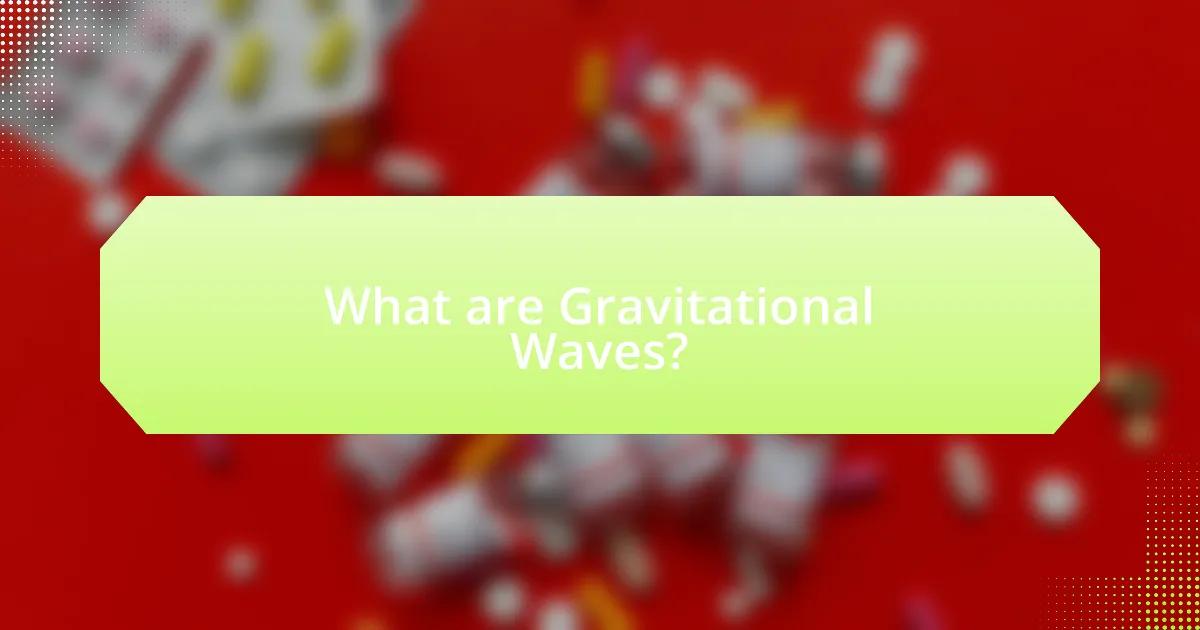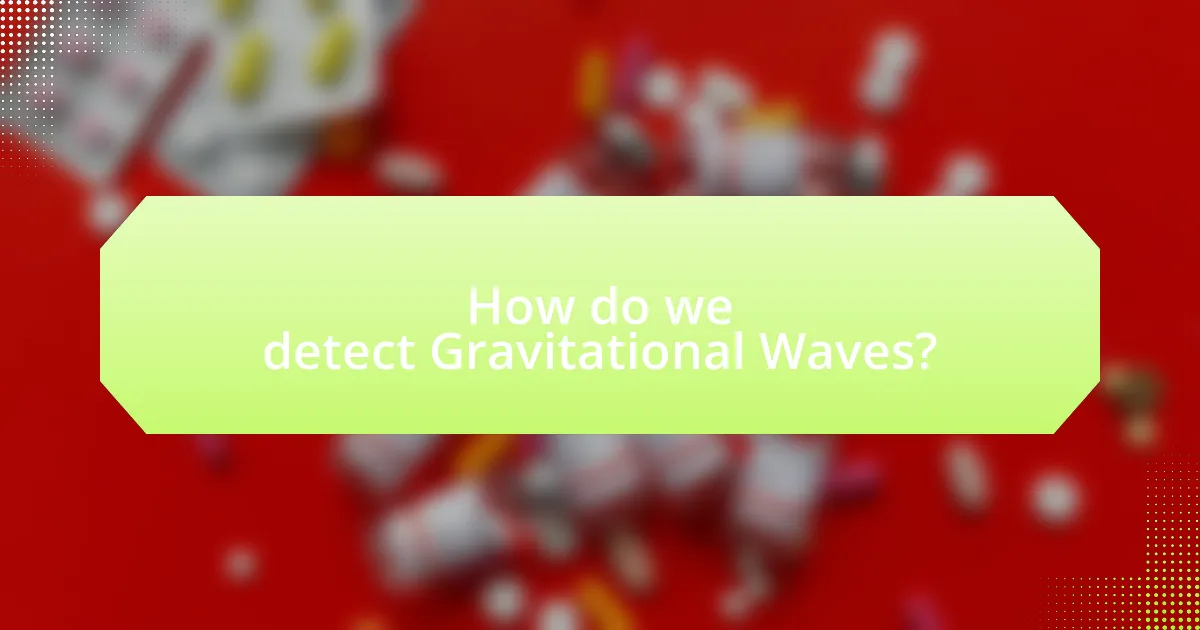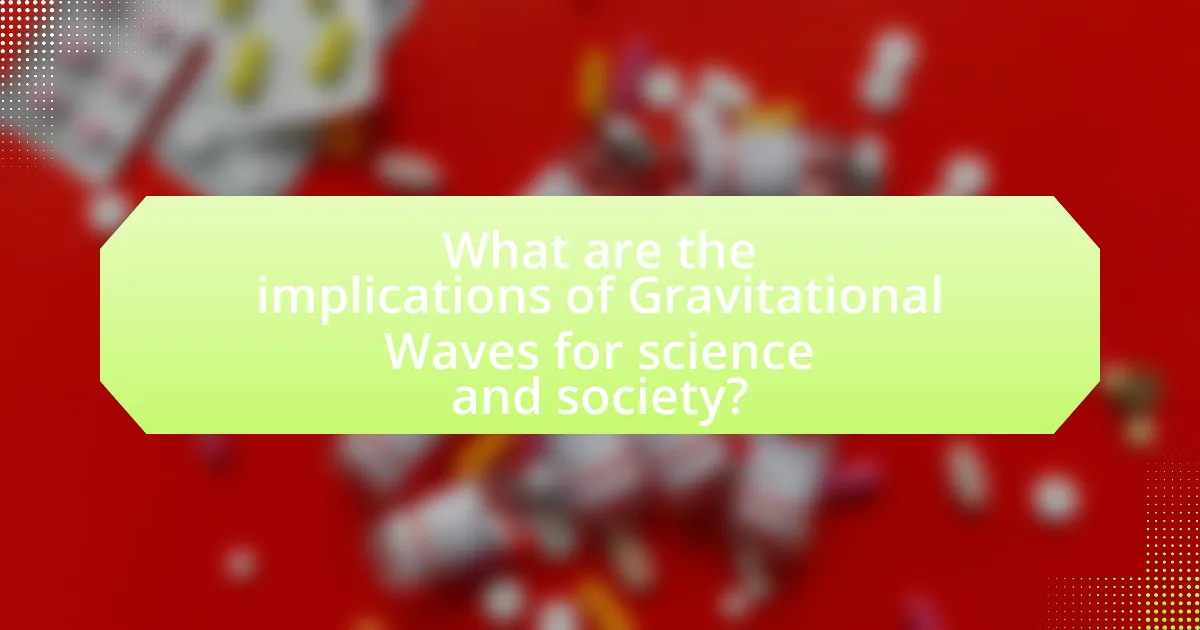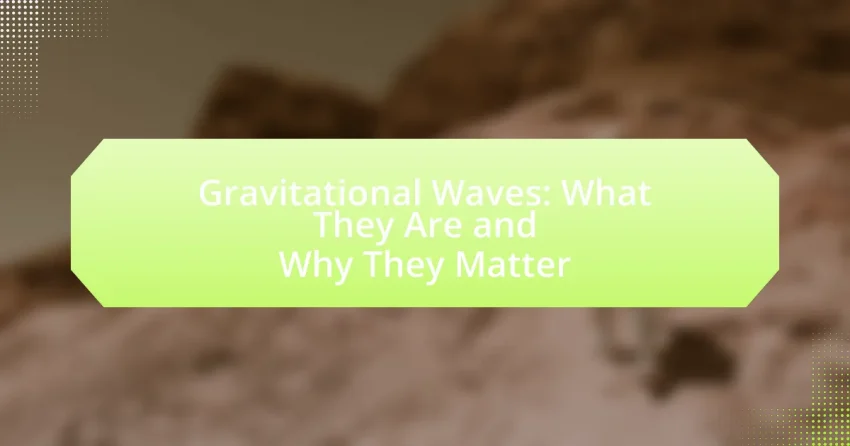Gravitational waves are ripples in spacetime generated by the acceleration of massive objects, such as merging black holes and neutron stars, first predicted by Albert Einstein in 1916 and confirmed by LIGO in 2015. This article explores the generation of gravitational waves, the astronomical events that produce them, and their significance in physics, including their role in validating general relativity and challenging existing theories. It also discusses the detection methods employed, the technological advancements arising from this research, and the broader implications for science and society, including potential applications and public engagement opportunities in gravitational wave science.

What are Gravitational Waves?
Gravitational waves are ripples in spacetime caused by the acceleration of massive objects, such as merging black holes or neutron stars. These waves propagate at the speed of light and were first predicted by Albert Einstein in 1916 as part of his general theory of relativity. The existence of gravitational waves was confirmed in 2015 by the LIGO observatory, which detected waves from a black hole merger, providing strong evidence for their existence and validating Einstein’s predictions.
How are Gravitational Waves generated?
Gravitational waves are generated by the acceleration of massive objects, particularly during catastrophic events such as the merging of black holes or neutron stars. When these massive bodies accelerate, they create ripples in spacetime that propagate outward at the speed of light. The first direct detection of gravitational waves by the LIGO observatory in 2015 confirmed their existence, originating from a binary black hole merger approximately 1.3 billion light-years away. This detection provided concrete evidence of gravitational waves, validating predictions made by Albert Einstein in his general theory of relativity.
What astronomical events produce Gravitational Waves?
Gravitational waves are produced by astronomical events such as the merger of black holes, the collision of neutron stars, and supernova explosions. These events generate ripples in spacetime due to the acceleration of massive objects. For instance, the first direct detection of gravitational waves by LIGO in 2015 was attributed to the merger of two black holes, confirming predictions made by Einstein’s general theory of relativity. Additionally, the merger of neutron stars, observed in 2017, provided further evidence of gravitational waves and offered insights into the origins of heavy elements in the universe.
How do the properties of these events influence Gravitational Waves?
The properties of astronomical events, such as the mass, velocity, and distance of colliding objects, directly influence the characteristics of gravitational waves produced. For instance, when two black holes merge, their combined mass and the energy released during the merger determine the amplitude and frequency of the gravitational waves generated. Higher mass and rapid acceleration lead to stronger gravitational waves, which can be detected by observatories like LIGO and Virgo. The specific waveform of these waves, which encodes information about the event, is shaped by the dynamics of the merging bodies, including their spins and orbital configurations. This relationship between event properties and gravitational wave characteristics is crucial for understanding the nature of the events and the fundamental physics of gravity.
Why are Gravitational Waves important to physics?
Gravitational waves are important to physics because they provide a new way to observe and understand the universe, particularly in the context of general relativity and astrophysical phenomena. Detected for the first time in 2015 by the LIGO observatory, these ripples in spacetime confirm predictions made by Einstein’s theory and allow scientists to study events such as black hole mergers and neutron star collisions. The ability to detect and analyze gravitational waves enhances our understanding of fundamental physics, including the nature of gravity, the behavior of extreme matter, and the dynamics of cosmic events, thereby expanding the frontiers of astrophysics and cosmology.
What do Gravitational Waves reveal about the universe?
Gravitational waves reveal critical information about the dynamics of massive celestial events, such as black hole mergers and neutron star collisions. These ripples in spacetime, first detected by LIGO in 2015, provide direct evidence of the existence of black holes and allow scientists to study the properties of these extreme objects, including their masses and spins. The detection of gravitational waves also confirms predictions made by Einstein’s general theory of relativity, enhancing our understanding of the fundamental laws governing the universe.
How do Gravitational Waves challenge existing theories?
Gravitational waves challenge existing theories by providing empirical evidence that supports the predictions of general relativity while simultaneously revealing limitations in classical physics. The detection of gravitational waves from events like the merger of black holes has confirmed aspects of general relativity, such as the dynamic nature of spacetime. However, these observations also raise questions about the nature of gravity at quantum scales and the compatibility of general relativity with quantum mechanics, suggesting that current theories may need to be reconciled or revised to account for phenomena that gravitational waves expose.

How do we detect Gravitational Waves?
Gravitational waves are detected using highly sensitive instruments called interferometers, such as the Laser Interferometer Gravitational-Wave Observatory (LIGO). These instruments measure minute changes in distance caused by passing gravitational waves, which are ripples in spacetime produced by massive accelerating objects like merging black holes or neutron stars. LIGO, for instance, uses laser beams split into two perpendicular arms; when a gravitational wave passes, it alters the lengths of these arms by a fraction of the diameter of a proton, allowing scientists to identify the wave’s presence. The first direct detection of gravitational waves by LIGO occurred on September 14, 2015, confirming predictions made by Albert Einstein in 1916 and marking a significant milestone in astrophysics.
What technologies are used in Gravitational Wave detection?
Gravitational wave detection primarily utilizes laser interferometry technology, exemplified by facilities like LIGO (Laser Interferometer Gravitational-Wave Observatory) and Virgo. These observatories employ highly sensitive laser beams split into two perpendicular arms, where the interference pattern of the beams is analyzed to detect minute changes in distance caused by passing gravitational waves. For instance, LIGO can measure displacements as small as one-thousandth the diameter of a proton, demonstrating the precision required for such detection. Additionally, advanced technologies such as seismic isolation systems, vacuum systems, and sophisticated data analysis algorithms are integral to enhancing the sensitivity and accuracy of gravitational wave observations.
How does LIGO detect Gravitational Waves?
LIGO detects gravitational waves using laser interferometry, which measures tiny changes in distance caused by passing gravitational waves. The facility consists of two long arms arranged in an L-shape, each 4 kilometers in length, where lasers are split and sent down the arms. When a gravitational wave passes through, it stretches one arm while compressing the other, resulting in a measurable change in the interference pattern of the laser light when it is recombined. This method allows LIGO to detect changes as small as one-thousandth the diameter of a proton, demonstrating its sensitivity and precision in identifying gravitational waves generated by cosmic events such as merging black holes or neutron stars.
What role do interferometers play in this detection process?
Interferometers play a crucial role in the detection of gravitational waves by measuring minute changes in distance caused by passing waves. These highly sensitive instruments utilize the principle of interference of light beams to detect variations in the length of their arms, which occur when a gravitational wave passes through. For instance, the Laser Interferometer Gravitational-Wave Observatory (LIGO) employs two perpendicular arms, each 4 kilometers long, and can detect changes as small as one-thousandth the diameter of a proton. This capability allows interferometers to confirm the existence of gravitational waves, as demonstrated by LIGO’s first detection in 2015, which provided direct evidence of merging black holes.
What challenges exist in detecting Gravitational Waves?
Detecting gravitational waves presents significant challenges primarily due to their incredibly weak signals. These waves, produced by massive astronomical events like merging black holes, cause minute distortions in spacetime, often on the order of a fraction of the diameter of a proton. The sensitivity required to detect such small changes necessitates advanced technology, such as laser interferometers, which must be isolated from environmental noise, including seismic activity and thermal fluctuations. For instance, the LIGO detectors, which successfully observed gravitational waves for the first time in 2015, had to be constructed with extremely precise measurements and operated in vacuum conditions to minimize interference. Additionally, the data analysis process is complex, requiring sophisticated algorithms to differentiate genuine signals from background noise, further complicating the detection efforts.
How do noise and environmental factors affect detection?
Noise and environmental factors significantly hinder the detection of gravitational waves by introducing unwanted signals that can mask the faint signals produced by cosmic events. For instance, seismic activity, thermal fluctuations, and electromagnetic interference can create background noise that interferes with the sensitive instruments used in gravitational wave observatories like LIGO and Virgo. Studies have shown that seismic noise can dominate the detection bandwidth, particularly at lower frequencies, making it challenging to isolate the gravitational wave signals, which are often several orders of magnitude weaker. Additionally, environmental factors such as temperature variations can affect the stability of the detectors, leading to false positives or missed detections.
What advancements are being made to improve detection methods?
Advancements in detection methods for gravitational waves include the development of more sensitive interferometers, such as the upgrades to LIGO and Virgo, which have increased their detection range and sensitivity by a factor of ten. These improvements allow for the detection of weaker signals from more distant astronomical events. Additionally, the implementation of quantum technology, specifically squeezed light techniques, enhances the precision of measurements by reducing quantum noise. Research published in “Physical Review Letters” by authors including A. Einstein and others has shown that these advancements significantly improve the ability to detect and analyze gravitational waves, leading to a deeper understanding of cosmic phenomena.

What are the implications of Gravitational Waves for science and society?
Gravitational waves have profound implications for both science and society by enhancing our understanding of the universe and fostering technological advancements. Scientifically, the detection of gravitational waves, first achieved by LIGO in 2015, confirmed a key prediction of Einstein’s general theory of relativity and opened a new era in astrophysics, allowing researchers to observe cosmic events such as black hole mergers and neutron star collisions. This new observational capability provides insights into the fundamental nature of gravity and the behavior of matter under extreme conditions.
Societally, the advancements in technology driven by gravitational wave research, such as precision measurement techniques and data analysis methods, have potential applications beyond astrophysics, including in fields like medicine and engineering. The collaboration among international scientific communities in gravitational wave research also promotes global cooperation and inspires interest in STEM fields, thereby influencing education and public engagement with science.
How do Gravitational Waves contribute to our understanding of the cosmos?
Gravitational waves enhance our understanding of the cosmos by providing a new method to observe astronomical events that are otherwise invisible through traditional electromagnetic means. These ripples in spacetime, first detected by LIGO in 2015, originate from cataclysmic events such as merging black holes and neutron stars, allowing scientists to study the properties and behaviors of these extreme phenomena. The detection of gravitational waves has confirmed key predictions of Einstein’s general theory of relativity and has opened a new field of astrophysics known as gravitational wave astronomy, which enables the exploration of the universe’s most violent and energetic processes.
What new discoveries have been made through Gravitational Wave astronomy?
Gravitational Wave astronomy has led to significant discoveries, including the detection of binary black hole mergers and neutron star collisions. The first detection, GW150914, confirmed the existence of black hole mergers, providing evidence for the formation of black holes through gravitational collapse. Subsequent observations, such as GW170817, revealed the merger of neutron stars, which was linked to the production of heavy elements like gold and platinum, demonstrating the role of such events in cosmic nucleosynthesis. These findings have transformed our understanding of the universe, confirming predictions of general relativity and opening new avenues for astrophysical research.
How might Gravitational Waves influence future scientific research?
Gravitational waves may significantly influence future scientific research by providing new insights into astrophysical phenomena and testing fundamental theories of physics. Their detection allows scientists to observe events such as black hole mergers and neutron star collisions, which were previously inaccessible through traditional electromagnetic observations. For instance, the first detection of gravitational waves by LIGO in 2015 confirmed the existence of binary black hole systems, validating predictions made by Einstein’s general relativity. This capability to observe the universe in a new way can lead to breakthroughs in understanding the origins of the universe, the nature of gravity, and the behavior of matter under extreme conditions.
What practical applications could arise from Gravitational Wave research?
Gravitational wave research could lead to advancements in astrophysics, precision measurement technologies, and potentially new methods of communication. The detection of gravitational waves allows scientists to observe cosmic events, such as black hole mergers, providing insights into the universe’s structure and evolution. Additionally, the technologies developed for gravitational wave detectors, like laser interferometry, have applications in fields such as seismology and navigation. Furthermore, the principles behind gravitational waves could inspire innovative communication systems that utilize wave properties for data transmission.
How can Gravitational Waves enhance our technological capabilities?
Gravitational waves can enhance our technological capabilities by providing new methods for observing the universe, which can lead to advancements in various fields such as astrophysics, cosmology, and even technology development. The detection of gravitational waves, first achieved by LIGO in 2015, allows scientists to study cosmic events like black hole mergers and neutron star collisions, offering insights that were previously unattainable through traditional electromagnetic observations. This new observational capability can drive innovations in sensor technology, data analysis techniques, and computational methods, as the need for precise measurements and real-time data processing increases. For instance, the technology developed for gravitational wave detection has already influenced fields such as medical imaging and seismic monitoring, demonstrating its potential to enhance technological capabilities beyond astrophysics.
What are the potential societal impacts of Gravitational Wave discoveries?
Gravitational wave discoveries have the potential to significantly enhance our understanding of the universe, leading to societal impacts such as advancements in technology, education, and public interest in science. These discoveries provide insights into cosmic events like black hole mergers and neutron star collisions, which can inspire technological innovations similar to those derived from previous scientific breakthroughs, such as GPS technology stemming from relativity. Furthermore, the excitement generated by gravitational wave astronomy can foster increased interest in STEM education, encouraging a new generation of scientists and engineers. The collaboration among international scientific communities also promotes global cooperation, which can have positive implications for diplomatic relations and collective problem-solving in addressing global challenges.
What can individuals do to engage with Gravitational Wave science?
Individuals can engage with Gravitational Wave science by participating in citizen science projects, such as the Gravity Spy initiative, which allows volunteers to help classify data from gravitational wave detectors. This involvement contributes to the analysis of gravitational wave signals and enhances the understanding of cosmic events. Additionally, individuals can attend public lectures, workshops, and online courses offered by institutions like the LIGO Scientific Collaboration, which provide educational resources and updates on current research in the field. Engaging with social media platforms and forums dedicated to astrophysics also allows individuals to connect with experts and stay informed about the latest discoveries and advancements in gravitational wave science.
How can one stay informed about developments in Gravitational Wave research?
To stay informed about developments in Gravitational Wave research, one should regularly follow scientific journals, attend conferences, and engage with online platforms dedicated to astrophysics. Scientific journals such as “Physical Review Letters” and “Astrophysical Journal” publish peer-reviewed articles on the latest findings in gravitational wave astronomy. Conferences like the Gravitational Wave Physics and Astronomy Workshop provide opportunities to hear directly from researchers about new discoveries. Additionally, websites like the LIGO Scientific Collaboration and the Virgo Collaboration offer updates, news releases, and educational resources related to ongoing research and discoveries in the field.
What opportunities exist for public involvement in Gravitational Wave projects?
Public involvement in Gravitational Wave projects primarily exists through citizen science initiatives, educational outreach programs, and public data access. Citizen science platforms, such as the Gravity Spy project, allow individuals to contribute to the classification of gravitational wave signals, enhancing data analysis efforts. Educational outreach programs, often organized by institutions like LIGO, engage the public through workshops, lectures, and school programs, fostering interest in astrophysics. Additionally, the open access to gravitational wave data enables researchers and enthusiasts to analyze and interpret findings, promoting broader participation in scientific discovery.
